Setting up a nativity scene for Christmas celebrations is a given. A walk around any city, where Christmas is celebrated, shows you that familiar scene from the manger which marks the miraculous birth of baby Jesus. We are all familiar with little statues of Mary and Joseph, the shepherd boys, the Magi, three wise men, the barn animals and so on. But in Barcelona, and in effect Catalunya, there’s an additional member added to this mix. The Caganer. Or its literal English translation — The Defecator or The Crapper! Yes, that is the most polite way to put it. This is basically a clay or ceramic-figurine of a peasant in a squatting position ready to defecate. From the front, everything looks sane, but turn the figure around and things get interesting. It’s not purely symbolic, but actually shows graphic details such as a figurine with bare butts and a glob of ‘brown-coloured deposit’ below them. This figurine forms part of the Nativity Scene in the Catalan regions. [caption id=“attachment_3181546” align=“alignnone” width=“825”]
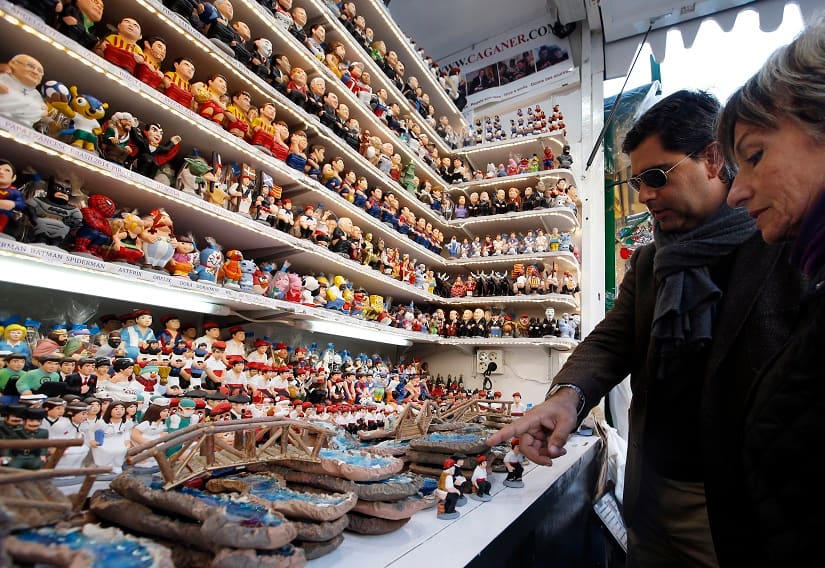 Costumers look at clay “caganers” at the Santa Llucia Christmas market in central Barcelona. Reuters Photo[/caption] Fertilising the land In the Indian construct, a defecating figurine as part of a holy scene sounds disturbing. But in Catalunya, this is a tradition which has its roots in the 18th century. Joan Amades, an eminent 19th century Catalan ethnologist defines the Caganer is a customary figure in the ‘pessebre’ or the nativity scenes. In those days, the Caganers’ ‘deposit’ fertilised the ground of the Nativity Scene, thus keeping it fertile for the next year. Alongside, it also ensured a healthy body and peaceful mind. Placing it in the manger also ensured good luck and joy. Failure to put a Caganer within the manger brought adversity as well, according to Amades. It happens to be the most popular nativity figure in Catalonia. “When I was a kid, every December I prepared the pessebre in my living room with my father. It was like a game, to find the right spot to place the Caganer, hide it behind the bushes or behind a piece of cork that simulated the mountains of the landscape”, reminisces Marta Ballesta, a journalist living in Barcelona. As it would be disrespectful to have a defecating figurine anywhere near the crib, the Caganer forms part of the backdrop. In fact, in elaborate nativity scene installations, children play a game of spotting the Caganer. “For farmers and peasants, in the olden days the excrement could act as a fertilise as there were no agro-chemicals then. The Caganer in effect is a symbol of fertility,” says Ballesta. In fact, legends even says that a farmer would have a bad agricultural output if he did not put a Caganer in the Nativity Scene. [caption id=“attachment_3181548” align=“alignnone” width=“825”]
Costumers look at clay “caganers” at the Santa Llucia Christmas market in central Barcelona. Reuters Photo[/caption] Fertilising the land In the Indian construct, a defecating figurine as part of a holy scene sounds disturbing. But in Catalunya, this is a tradition which has its roots in the 18th century. Joan Amades, an eminent 19th century Catalan ethnologist defines the Caganer is a customary figure in the ‘pessebre’ or the nativity scenes. In those days, the Caganers’ ‘deposit’ fertilised the ground of the Nativity Scene, thus keeping it fertile for the next year. Alongside, it also ensured a healthy body and peaceful mind. Placing it in the manger also ensured good luck and joy. Failure to put a Caganer within the manger brought adversity as well, according to Amades. It happens to be the most popular nativity figure in Catalonia. “When I was a kid, every December I prepared the pessebre in my living room with my father. It was like a game, to find the right spot to place the Caganer, hide it behind the bushes or behind a piece of cork that simulated the mountains of the landscape”, reminisces Marta Ballesta, a journalist living in Barcelona. As it would be disrespectful to have a defecating figurine anywhere near the crib, the Caganer forms part of the backdrop. In fact, in elaborate nativity scene installations, children play a game of spotting the Caganer. “For farmers and peasants, in the olden days the excrement could act as a fertilise as there were no agro-chemicals then. The Caganer in effect is a symbol of fertility,” says Ballesta. In fact, legends even says that a farmer would have a bad agricultural output if he did not put a Caganer in the Nativity Scene. [caption id=“attachment_3181548” align=“alignnone” width=“825”]
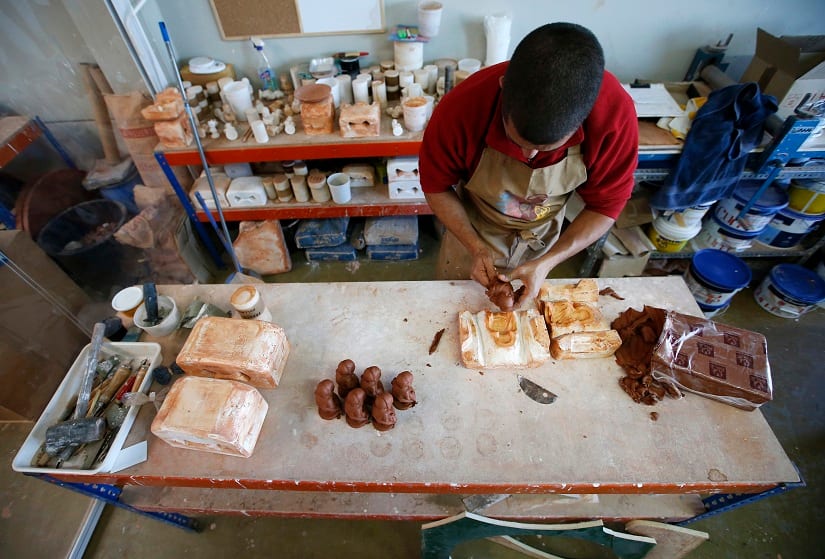 A man makes a Pope Francis “caganer” with a mould in a pottery in Torroella de Montgri, near Girona. Reuters Photo[/caption] Hand-made and hand-painted
El Caganer
is a family run establishment which specialises in hand-made and hand-painted Caganers. In operation since 1992, this North Catalunya-based establishment started off by making all the elements of the Nativity Scene. Since the last 10 years however, they have specialised in making Caganers. “Caganers are mostly used in Christmas, but nowadays it is fast becoming a souvenir from the Catalan culture,” says Marc Alos, an artist with El Caganer. And the demand is not just in Catalunya, but global. “Some years ago, we sold mostly directly in Barcelona by Christmas time, but now the product has become popular overseas,” say Alos, boasting of a client list from USA, Spain, France, Germany among countries. He also pointed to the fact that around 50 percent of all their Caganers are sold outside Catalunya. [caption id=“attachment_3181552” align=“alignnone” width=“825”]
A man makes a Pope Francis “caganer” with a mould in a pottery in Torroella de Montgri, near Girona. Reuters Photo[/caption] Hand-made and hand-painted
El Caganer
is a family run establishment which specialises in hand-made and hand-painted Caganers. In operation since 1992, this North Catalunya-based establishment started off by making all the elements of the Nativity Scene. Since the last 10 years however, they have specialised in making Caganers. “Caganers are mostly used in Christmas, but nowadays it is fast becoming a souvenir from the Catalan culture,” says Marc Alos, an artist with El Caganer. And the demand is not just in Catalunya, but global. “Some years ago, we sold mostly directly in Barcelona by Christmas time, but now the product has become popular overseas,” say Alos, boasting of a client list from USA, Spain, France, Germany among countries. He also pointed to the fact that around 50 percent of all their Caganers are sold outside Catalunya. [caption id=“attachment_3181552” align=“alignnone” width=“825”]
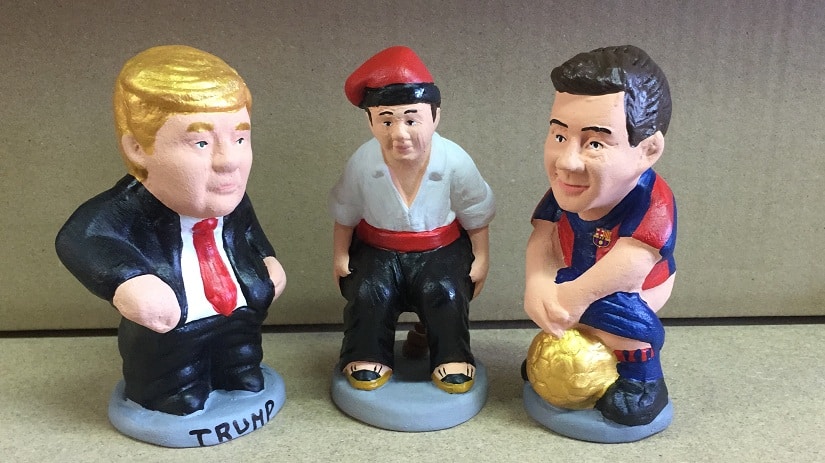 While Trump and Messi Caganers are popular, the traditional one in the red Barretina sells the most. Image courtesy: El Caganers[/caption] Shakira, Messi, Narendra Modi Caganers, anyone? While the provenance of the Caganers may have had a cultural significance, commerce has eventually reared its ugly head. Traditionally Caganers are ceramic or clay figurines showing the peasant wearing a white shirt, black trousers and a red floppy hat known as barretina. Sometimes the peasant also has shawl wrapped around the body. But of late, celebrity Caganers are a big draw in the Fira de Santa Llúcia Christmas market in Barcelona. Everyone from famous footballers to politicians to film stars have their Caganer equivalent, ready to be purchased. A look at
their website
, and you will notice different categories, with Caganers depicting everyone from the Pope to Messi to Trump to Queen Elizabeth to our very own Narendra Modi. Yes, these figurines when seen from the front appear normal, but turn them around for a chuckle or two. Considering the general tolerance levels of the world going down, how does El Caganer get away with this depiction of celebrities? There’s even the Pope in the list! “Here in Catalunya, celebrities are pleased if we depict them as Caganers! It is not meant to be offensive, but is looked at with honour,” says Alos. There has never been an instance when the shop had to stop production of some popular celebrity Caganer. Having a Caganer in the likeness of the Pope, in Catalunya which is a majority Catholic region, speaks volumes. [caption id=“attachment_3181554” align=“alignnone” width=“825”]
While Trump and Messi Caganers are popular, the traditional one in the red Barretina sells the most. Image courtesy: El Caganers[/caption] Shakira, Messi, Narendra Modi Caganers, anyone? While the provenance of the Caganers may have had a cultural significance, commerce has eventually reared its ugly head. Traditionally Caganers are ceramic or clay figurines showing the peasant wearing a white shirt, black trousers and a red floppy hat known as barretina. Sometimes the peasant also has shawl wrapped around the body. But of late, celebrity Caganers are a big draw in the Fira de Santa Llúcia Christmas market in Barcelona. Everyone from famous footballers to politicians to film stars have their Caganer equivalent, ready to be purchased. A look at
their website
, and you will notice different categories, with Caganers depicting everyone from the Pope to Messi to Trump to Queen Elizabeth to our very own Narendra Modi. Yes, these figurines when seen from the front appear normal, but turn them around for a chuckle or two. Considering the general tolerance levels of the world going down, how does El Caganer get away with this depiction of celebrities? There’s even the Pope in the list! “Here in Catalunya, celebrities are pleased if we depict them as Caganers! It is not meant to be offensive, but is looked at with honour,” says Alos. There has never been an instance when the shop had to stop production of some popular celebrity Caganer. Having a Caganer in the likeness of the Pope, in Catalunya which is a majority Catholic region, speaks volumes. [caption id=“attachment_3181554” align=“alignnone” width=“825”]
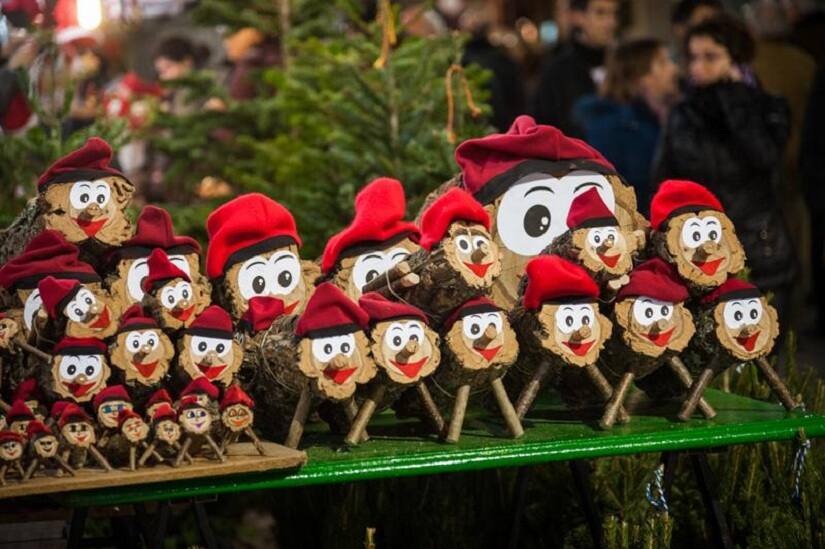 Tio de Nadal. Image: Fira de Santa Llucia archives[/caption] However, when it comes to the locals, the traditional figure is what is bought the most. According to Ballesta, in Catalan families the nativity figures are usually the same and are recycled every year. “There are families who have a tradition of adding on new figurines every year to expand the Nativity Scene. A few years ago, we saw these celebrity Caganers. There was a definite fun and novelty element there. Yes, we do reports of ‘New Caganer of the Year’ annually, to talk about which new figurine created the most buzz. But when it comes to buying one for the Nativity Scene, we stick to the one with the sash and the barretina,” says Ballesta. Among the celebrities, it is the of the genius FC Barcelona striker Lionel Messi who is the most popular celebrity Caganer, but outside Catalunya it has been the outgoing US President Barack Obama’s Caganer that sold in high numbers since he was elected in 2008. “This year, though, Donald Trump was a very good opponent to Messi,” says Alos. Eerily, just like we saw in the election results, in the sales of Caganers, Hillary Clinton started off strong, but was eventually trumped by Donald Trump. Among the Indian celebrities, they only sell the Narendra Modi Caganer. El Caganer has a fixed category of Caganers and most are depicted based on professions. According to Ballesta, Caganers depicting different professions — doctor, baker, cook, teacher — and so on, are given to friends and family if they want to add that element in their nativity scene. But it is not a popular gifting item as such within Catalunya. [caption id=“attachment_3181556” align=“alignnone” width=“825”]
Tio de Nadal. Image: Fira de Santa Llucia archives[/caption] However, when it comes to the locals, the traditional figure is what is bought the most. According to Ballesta, in Catalan families the nativity figures are usually the same and are recycled every year. “There are families who have a tradition of adding on new figurines every year to expand the Nativity Scene. A few years ago, we saw these celebrity Caganers. There was a definite fun and novelty element there. Yes, we do reports of ‘New Caganer of the Year’ annually, to talk about which new figurine created the most buzz. But when it comes to buying one for the Nativity Scene, we stick to the one with the sash and the barretina,” says Ballesta. Among the celebrities, it is the of the genius FC Barcelona striker Lionel Messi who is the most popular celebrity Caganer, but outside Catalunya it has been the outgoing US President Barack Obama’s Caganer that sold in high numbers since he was elected in 2008. “This year, though, Donald Trump was a very good opponent to Messi,” says Alos. Eerily, just like we saw in the election results, in the sales of Caganers, Hillary Clinton started off strong, but was eventually trumped by Donald Trump. Among the Indian celebrities, they only sell the Narendra Modi Caganer. El Caganer has a fixed category of Caganers and most are depicted based on professions. According to Ballesta, Caganers depicting different professions — doctor, baker, cook, teacher — and so on, are given to friends and family if they want to add that element in their nativity scene. But it is not a popular gifting item as such within Catalunya. [caption id=“attachment_3181556” align=“alignnone” width=“825”]
 A giant Tio de Nadal in front of Catedral. Image: Fira de Santa Llucia archives[/caption] Amics del Caganer “We try to cover all categories and make around 30-40 new Caganers annually. There are many people who collect Caganers,” says Alos. Yes, there is a global Caganer-collector association. Xavier Borrell, president of the
Associacio d’ Amics del Caganer
has around 1200 Caganers in his collection. The association which was formed in 1990 has over 80 members from various countries who are dedicated to preserving and promoting the cultural importance of this tradition. They even have their semi-annual newsletter called Caganofil, which covers every thing related to this beloved nativity figure. Borrell prefers collecting unique Caganers, and doesn’t necessarily buy every Caganer. In that sense this is similar to any other collection hobby, you buy some, you exchange some and build your collection. Borrell has bought Caganer figurines from not only Spain, but also Portugal, Cuba, Guatemala and even had one made of stone during a trip to South India. Speaking about his association members, Borrell says, “We organise two meetings annually. The one in June is a general meeting of the partners. The one in December involves meeting members from other countries and having a Christmas dinner with them. We have members in Japan too.” Some collectors are so adamant that they will not get rid of their collection, come what may. Jordi Llorach, who has collected over 400 Caganers was asked by his wife to move his collection out of their living room. So he made a museum of his collection,
in his bathroom
! So the popularity of this Catalan figurine is certainly not limited to Catalunya any more. But the theme of defecation also forms part of another Catalan Christmas tradition. Tio de Nadal Taking the whole act of pooping — not literally thankfully — to the next level is the Tio de Nadal or the Christmas trunk or Christmas log. So there is a log of wood which is painted with the face of a person, that is supposed to be ‘fed and taken care of’ by kids from the beginning of December. The kids actually cover the log with a shawl to protect it from the cold as well. As the month advances, so does the size of the log. Nothing miraculous there, just parents replacing logs every other week to show the kids that the log is growing, thanks to their care. What’s the point of this? Gifts!
A giant Tio de Nadal in front of Catedral. Image: Fira de Santa Llucia archives[/caption] Amics del Caganer “We try to cover all categories and make around 30-40 new Caganers annually. There are many people who collect Caganers,” says Alos. Yes, there is a global Caganer-collector association. Xavier Borrell, president of the
Associacio d’ Amics del Caganer
has around 1200 Caganers in his collection. The association which was formed in 1990 has over 80 members from various countries who are dedicated to preserving and promoting the cultural importance of this tradition. They even have their semi-annual newsletter called Caganofil, which covers every thing related to this beloved nativity figure. Borrell prefers collecting unique Caganers, and doesn’t necessarily buy every Caganer. In that sense this is similar to any other collection hobby, you buy some, you exchange some and build your collection. Borrell has bought Caganer figurines from not only Spain, but also Portugal, Cuba, Guatemala and even had one made of stone during a trip to South India. Speaking about his association members, Borrell says, “We organise two meetings annually. The one in June is a general meeting of the partners. The one in December involves meeting members from other countries and having a Christmas dinner with them. We have members in Japan too.” Some collectors are so adamant that they will not get rid of their collection, come what may. Jordi Llorach, who has collected over 400 Caganers was asked by his wife to move his collection out of their living room. So he made a museum of his collection,
in his bathroom
! So the popularity of this Catalan figurine is certainly not limited to Catalunya any more. But the theme of defecation also forms part of another Catalan Christmas tradition. Tio de Nadal Taking the whole act of pooping — not literally thankfully — to the next level is the Tio de Nadal or the Christmas trunk or Christmas log. So there is a log of wood which is painted with the face of a person, that is supposed to be ‘fed and taken care of’ by kids from the beginning of December. The kids actually cover the log with a shawl to protect it from the cold as well. As the month advances, so does the size of the log. Nothing miraculous there, just parents replacing logs every other week to show the kids that the log is growing, thanks to their care. What’s the point of this? Gifts!
“The children are expected to beat the Tio or log, on Christmas day. Literally begging the log to defecate gifts. They sing a Catalan song, ‘Caga, tió / ametlles i torró’ while beating the log. (That translates to “Poop, trunk, almonds and nougat.) It is usually done with gifts of not much value which are hidden under the blanket covering the log. When you finish, the blanket is lifted and the kids find the gifts,” explains Ballesta. This is the translated version of the Catalan song: Sh*t, log, Sh*t nougats (turrón), Hazelnuts and mató cheese, If you don’t sh*t well, I’ll hit you with a stick, Sh*t, log! So next time you are in Europe and see some kids beating the living daylights out of a log of wood, or spot a defecating figurine inside the nativity scene, don’t freak out. It’s tradition. Enjoy it. Maybe buy one. I know I’m booking some Messi Caganers.
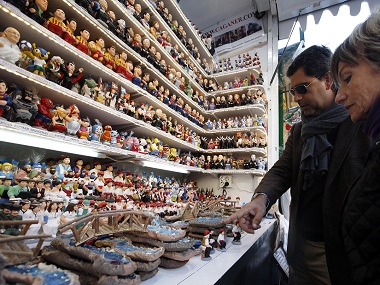)